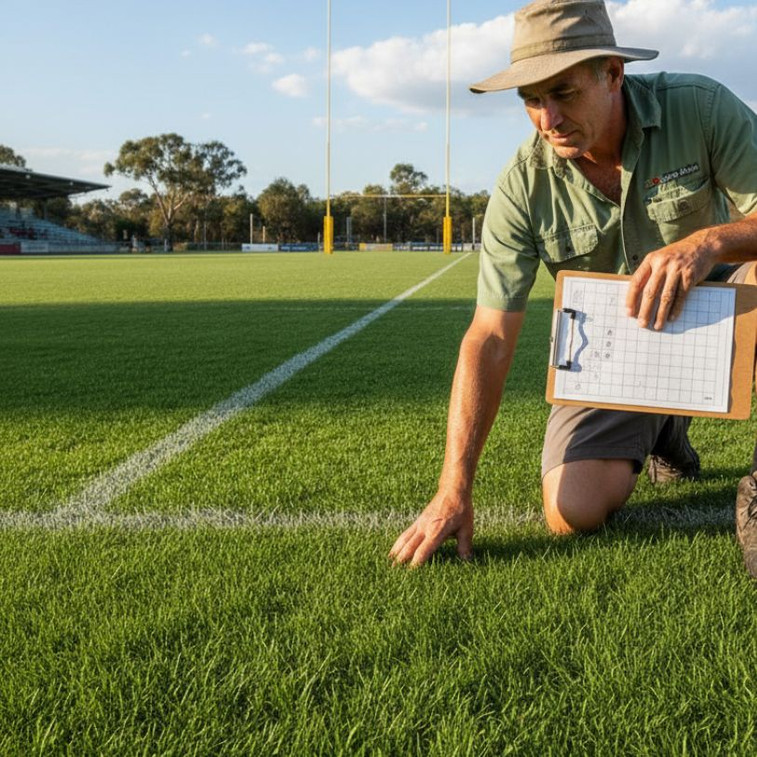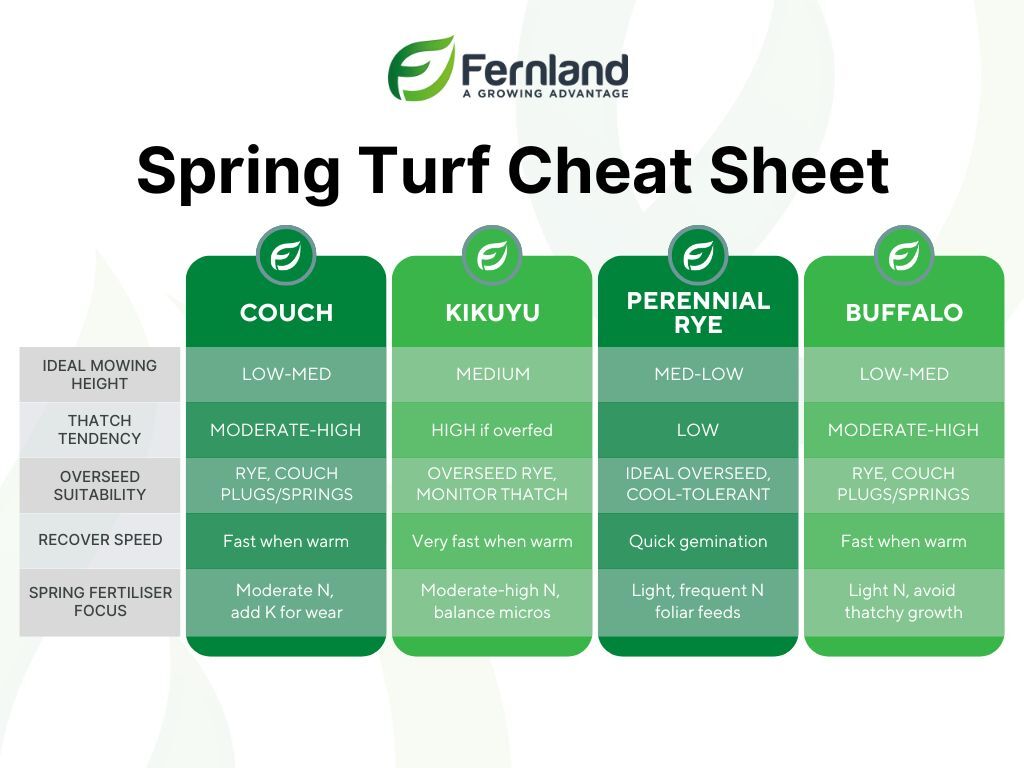
Spring Turf Rehab in Australia: How to Repair Winter Damage on Sports Fields
Posted by Jason on 7th Oct 2025
After a tough winter, the damage is obvious.
Most Australian school ovals and community sports fields show the same wear patterns.
Soggy goal mouths that won't drain.
Compacted centre circles where roots can't breathe.
Mossy corners in shaded areas where sunlight barely penetrates.
Line markings have faded to ghosts. The turf surface feels tired underfoot. And the first spring fixtures are already filling the calendar.
This comprehensive guide provides turf managers with a proven, Australia-adapted spring turf rehabilitation plan—complete with diagnostic methods, repair protocols, and budget-conscious strategies to restore resilient, playable surfaces before competition season begins.
What's Wrong? 7 Signs Your Field Needs Work
Walk your field and look for these problems:
1. Hard, Compacted Soil
Stick a screwdriver, or soil probe, in the ground. Does it stop within 5 cm? That's compaction. Roots can't grow, water can't drain.
2. Thick Thatch Layer
That spongy brown mat between the grass and soil. If it's thicker than 1.5 cm, it holds too much water and breeds disease.
3. Bare Patches
From mowing too low, too much foot traffic, or equipment damage when it was wet.
4. Moss and Algae
Green slime on the surface means poor drainage, too much shade, or compacted soil.
5. Weeds Taking Over
Winter grass, clover, flatweeds filling in where your turf is thin.
6. Drainage Problems
Puddles that sit for days. Dry patches where sprinklers don't reach. Blocked drains.
7. Dead Shady Spots
South side of the field, under trees—stays cold and wet all winter.
Got 3 or more of these?
You need spring rehab. Here's how to fix it.
The 9-Step Fix (6-8 Weeks to Match-Ready)
Do these in order. Don't skip steps.
Step 1: Aerate (Week 1)
What it does: Punches holes in hard soil so air, water, and roots can get through.
When: Early September (or when soil is moist but not muddy).
How:
- Hire a contractor or rent equipment
- Use hollow-tine coring for bad compaction
- Use solid tines for quick jobs
- Do it early in the week so it recovers before weekend games
Cost: $200-500 per field
Detailed information on soil drainage testing is available from STRI Australia.
Step 2: Remove Thatch (Week 1-2)
What it does: Cuts through that spongy brown layer so water reaches the soil.
When: Right after aerating, once new growth starts.
How:
- Light scarify or verticut (don't go too deep)
- Sweep up all the debris
- If your turf is already thin, go easy—don't make it worse
Step 3: Topdress (Week 2)
What it does: Levels out bumps, fills holes from aeration, improves firmness.
What to use: Clean sand or sandy loam (no weeds, no clay).
How much: Light dusting—about 5-10 m³ per hectare (you should still see grass through it).
How:
- Spread it right after aeration
- Drag it smooth with a mat or lute
- Don't bury your grass
Check out Fernland's favourite topdressing equipment.
Step 4: Overseed Bare Areas (Week 2-3)
Goal: Fill in bare patches before weeds do.
What to plant:
- Perennial ryegrass (VIC, SA, TAS) – sprouts in 7-10 days, tough
- Couch (QLD, NSW warm areas) – use runners/plugs, needs warm soil (18°C+)
- Kikuyu (WA coast) – spreads fast, use runners
How:
- Rough up bare spots with a rake
- Spread seed (follow the bag rate—usually 25-35 g/m²)
- Roll lightly so seed touches soil
- Water lightly 2-3 times a day until it sprouts
Protect it: Rope off seeded areas. No training for 3-4 weeks.
University research on turf wear tolerance for community sports fields provides data on species performance.
What Grass Species Should You Use?

Step 5: Feed It (Week 3+)
Why: Winter rain washes nutrients away. Plants need food to recover.
What to use: Slow-release fertiliser with NPK (nitrogen, phosphorus, potassium).
How:
- Small amounts every 2-3 weeks (don't dump it all at once)
- 20-30 kg nitrogen per hectare per application
- Follow the bag instructions
Brisbane City Council provides sports field maintenance guidelines for local groundskeepers.
Warning: Too much too soon = disease and soft grass.
Step 6: Fix Your Sprinklers (Week 1-2)
Check your irrigation before you start seeding.
Look for:
- Broken heads
- Uneven coverage (some spots too wet, some too dry)
- Blocked nozzles
- Wrong pressure
Watering schedule:
- First 2 weeks (germination): Light watering 2-3 times a day (just keep it moist)
- Weeks 3-5: Once a day, deeper watering
- Week 6+: 2-3 times a week, deep soaking
Step 7: Watch for Weeds and Disease (Ongoing)
Common problems:
- Algae (green slime)
- Leaf spot (brown spots on grass)
- Weeds in thin areas
Fix it:
- Try simple stuff first: improve drainage, mow higher, prune trees for more sun
- Use wetting agents if water beads up on the surface
- Only spray chemicals if you have to (follow label exactly, wear gloves, keep people off)
Log everything you spray (what, when, how much).
Shop our range of turf-safe herbicides and fungicides.
Check all chemical product registrations through the APVMA database before purchase.
Step 8: Keep People Off New Growth (Weeks 1-4)
This is critical. Walking on new seedlings kills them.
How to protect:
- Rope off goal mouths
- Put up signs ("Reseeding—Keep Off")
- Move training to other parts of the field
- Shift portable goals
- Wait 3-4 weeks minimum
Test: Mow once. If seedlings don't lift, you can start light training.
Step 9: Paint Lines (Week 4-5)
Wait until after the first successful mow. Painting too early damages new grass.
Use low-pressure spray. Keep it clean.
Shop our range of range of line marking equipment and paint.
Quick Climate Guide: When to Start
- QLD/NT (tropical): August-September. Skip ryegrass, just maintain couch.
- NSW/SE QLD (subtropical): Late August-September. Ryegrass bridges until couch wakes up.
- VIC/SA/WA coast (temperate): September. Do ryegrass first.
- TAS/highlands (cool): September-October. Ryegrass only, watch for frost.
Simple rule: Soil needs to be 10°C+ for ryegrass, 18°C+ for couch.
Monitor your local soil temperature data through the Bureau of Meteorology.
What NOT to Do (Common Mistakes)
❌ Don't scalp (mow too low) in spring – You'll stress the grass
❌ Don't bury seed under thick topdressing – It won't sprout
❌ Don't overwater – Causes disease and shallow roots
❌ Don't skip the irrigation check – Uneven water = patchy grass
❌ Don't paint lines too early – You'll damage new growth
❌ Don't ignore shady spots – They need different treatment
❌ Don't train in the same spot every day – Spread the wear around
FAQs: Quick Answers
Q: How soon can we train after seeding?
A: 3-4 weeks minimum. Wait until you mow once without seedlings pulling up.
Q: Do I need gypsum?
A: Only if your soil test says so. For compaction, aeration works better.
Q: Can we do this during exam block?
A: Yes. Aerate and water during exams, seed after.
Q: When does ryegrass die off for couch?
A: November-December when nights warm up. Mow higher and reduce fertiliser to help couch take over.
Q: Is coring too messy for schools?
A: Do it Monday/Tuesday. Sweep up cores. Worth it for the results.
Q: Do wetting agents work?
A: Yes, if water beads on the surface. They help it soak in.
Q: What's the cheapest fix?
A: Aeration. Biggest bang for your buck.
Your Action Plan: Start This Week
Print this checklist. Go do it.
Week 1:
☐ Walk the field, take photos, mark problem spots
☐ Do the screwdriver test (compaction check)
☐ Book aeration contractor (they fill up fast)
☐ Order seed (perennial ryegrass or couch depending on location)
☐ Check irrigation—fix broken heads
☐ Tell coaches when the field will be closed
Week 2:
☐ Aerate
☐ Scarify if needed
☐ Topdress lightly
☐ Overseed bare patches
☐ Set up irrigation schedule
Weeks 3-4:
☐ Fertilise (small dose)
☐ Keep people off
☐ Water consistently
☐ Mow once (high setting)
Week 5+:
☐ Paint lines
☐ Open field for light training
☐ Keep monitoring
Start early = better results. Fields fixed in spring stay good all year.
Download the Checklist
[Get the Printable Spring Turf Checklist (PDF)] – Take it to the field with you.
Need supplies? Browse our complete sports turf maintenance range.
Bottom line: Aerate, seed, feed, water, protect. Do it in that order. Give it 6-8 weeks. Your field will be match-ready.
Questions? Most problems come from skipping steps or rushing. Follow the plan and it works.
